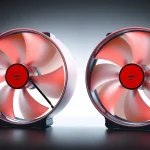Cisco Silicon One P200 and Cisco 8223 for 51.2T Networking Scale
In a rapidly evolving technological landscape, networking solutions are becoming increasingly important for companies aiming to leverage the growing capabilities of artificial intelligence (AI). Cisco's recent announcement of the Silicon One P200 chip, designed to support the Cisco 8223 switch, marks a significant advancement in this arena. This new technology promises to enhance networking efficiency and scalability, crucial elements as businesses strive to manage larger AI workloads across expansive infrastructures.
As companies increasingly seek to optimize their operations by situating computational resources near power generation sites, the need for robust networking solutions has never been more apparent. This week’s unveiling serves as a precursor to the upcoming OCP Summit 2025, where the focus will be on scale-across AI networking. The technology behind the Silicon One P200 is set to play a pivotal role in advancing this initiative.
- Understanding the Cisco Silicon One P200 Chip
- Programmability and Flexibility for Developers
- Deployment Scenarios and Evolution of Cisco Switches
- Compatibility and Future-Proofing
- The Importance of Security in AI Networks
- The Broader Impact on Networking Infrastructure
- Industry Comparisons and Competitor Insights
Understanding the Cisco Silicon One P200 Chip
The Cisco Silicon One P200 chip is designed to facilitate a remarkable 51.2 terabits per second (Tbps) throughput across networking infrastructures. While such speeds are not unprecedented, the chip distinguishes itself by addressing some of the most pressing challenges faced by data centers today.
One significant obstacle in high-speed networking is the need for substantial buffering capacity to manage the vast amounts of data transmitted between multiple data centers. In this context, the Silicon One P200 is engineered to handle these demands more efficiently than conventional switch chips.
- High throughput: The 51.2 Tbps capability supports the growing data requirements of AI applications.
- Enhanced buffering: Tailored to manage large volumes of data seamlessly.
- Scalability: Designed for easy integration with various data center configurations.
Programmability and Flexibility for Developers
A noteworthy feature of the Silicon One P200 is its P4 programmable network processor. This capability allows developers and network administrators to customize flow management, enabling more precise control over data traffic and improving overall network performance.
Programmable networking is crucial for modern enterprises that require the agility to adapt to changing demands. By utilizing the P4 processor, organizations can ensure their networking infrastructure remains aligned with their operational objectives.
Deployment Scenarios and Evolution of Cisco Switches
Cisco has illustrated several potential deployment scenarios for the new Silicon One P200 and the Cisco 8223 switch. These scenarios highlight the evolution of Cisco’s hardware, showcasing a two-year journey from the Cisco 8804 chassis switch to the more advanced Cisco 8223-64EH.
This transformation underscores a broader industry trend toward consolidating cross-data center routing directly within high-capacity switch platforms. Such consolidation not only streamlines operations but also enhances reliability and performance across the board.
Compatibility and Future-Proofing
The Cisco 8223 switch has been designed with versatility in mind. Currently, it supports the SONiC operating system and is set to include IOS XR in future updates. Compatibility with other models in the Nexus 9000 series, which also incorporate the Silicon One P200, will support NX-OS.
This commitment to compatibility ensures that organizations investing in Cisco's networking solutions can future-proof their infrastructures, adapting to technological advancements without the need for complete overhauls.
The Importance of Security in AI Networks
As organizations increasingly rely on AI clusters, security considerations become paramount. Cisco emphasizes that the capabilities of the P200 chip are not solely about performance; they also focus on enhancing security measures. Key security features are designed to:
- Prevent unauthorized access: Safeguarding sensitive data is critical in AI applications.
- Mitigate malicious activities: Proactive measures to counteract potential threats are essential.
- Support compliance: Ensuring alignment with regulatory requirements for data protection.
The Broader Impact on Networking Infrastructure
The introduction of the Silicon One P200 chip and the Cisco 8223 switch comes at a time when the industry is grappling with the complexities of building vast AI training clusters. As organizations expand their physical infrastructures, the *need to colocate computing resources near power sources* becomes increasingly important.
This trend necessitates advanced networking solutions that can bridge geographical distances while maintaining performance and reliability. Cisco’s innovations are well-positioned to support these evolving needs, allowing companies to operate effectively within mega campus data centers and beyond.
Industry Comparisons and Competitor Insights
In the competitive landscape of networking technology, other companies such as NVIDIA and Broadcom are also making strides. For instance, NVIDIA has introduced co-packaged optics with silicon photonics aimed at enhancing switching capabilities, while Broadcom continues to innovate in high-speed networking solutions.
These advancements across the sector illustrate a collective movement toward addressing the challenges of modern computing demands. Cisco's P200 and 8223 are integral parts of this narrative, but they must continuously evolve to keep pace with industry developments.
As we anticipate further innovations, it is crucial for organizations to stay informed and adaptable. The ability to leverage cutting-edge technology will define success in the increasingly competitive landscape of AI-driven networking.




Leave a Reply